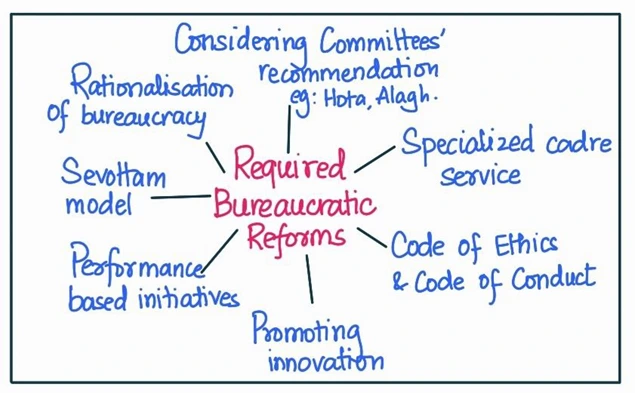Answer:
| Approach:
Introduction
- Begin with an overview of the traditional bureaucratic structure and its impact on socio-economic development in India.
Body
- Divide the body into multiple subsections, each discussing a specific aspect of the bureaucratic system that has hampered socio-economic development in India.
- Provide relevant examples to support the argument in each subsection.
Conclusion
- Conclude, emphasizing the need for further improvements to address the systemic challenges and facilitate the process of socio-economic development.
|
Introduction:
India’s traditional bureaucratic structure and culture have been criticized for hindering the country’s process of socio-economic development. The bureaucracy is known for its complex and time-consuming procedures, lack of transparency, and corrupt practices, which have often impeded the implementation of development policies and programs.
Body:
Listed below are various aspects of the bureaucratic system, as well as its impact on development:
- Red tape and inefficiency:
- The bureaucratic structure in India has been notorious for its red tape, which refers to excessive regulation and rigid conformity to rules. This often leads to delays in decision-making and implementation of policies and programs, thereby hindering socio-economic development.
- For instance, it takes a considerable amount of time to set up a new business in India due to the various clearances and permits required, which may discourage potential entrepreneurs and investors.
- Corruption:
- The traditional bureaucratic system in India has been plagued by corruption, leading to the misallocation of resources and reduced efficiency. This, in turn, hampers socio-economic development.
- For example, the 2G spectrum scam (2008) and the Commonwealth Games scandal (2010) resulted in significant financial losses and tarnished India’s global image.
- Centralized decision-making:
- The bureaucratic structure in India is characterized by centralized decision-making, which often leads to a lack of innovation and adaptability.
- For instance, the centralization of power in the hands of the Planning Commission (now replaced by NITI Aayog) resulted in a one-size-fits-all approach to development that did not address regional disparities.
- Insufficient coordination among departments:
- For example, the lack of coordination between the Ministry of Agriculture and the Ministry of Water Resources has resulted in the inefficient use of water resources and has hindered the development of sustainable agricultural practices.
- Resistance to change:
- For instance, the slow adoption of e-governance initiatives and digitization of government processes has led to inefficiencies in public service delivery and has not been able to fully harness the potential of information technology in improving governance.

Conclusion:
The traditional bureaucratic system in India has hindered socio-economic development. Reforms like e-governance, the Right to Information Act, and NITI Aayog show promise, but further efforts are needed to tackle systemic challenges and accelerate development.
